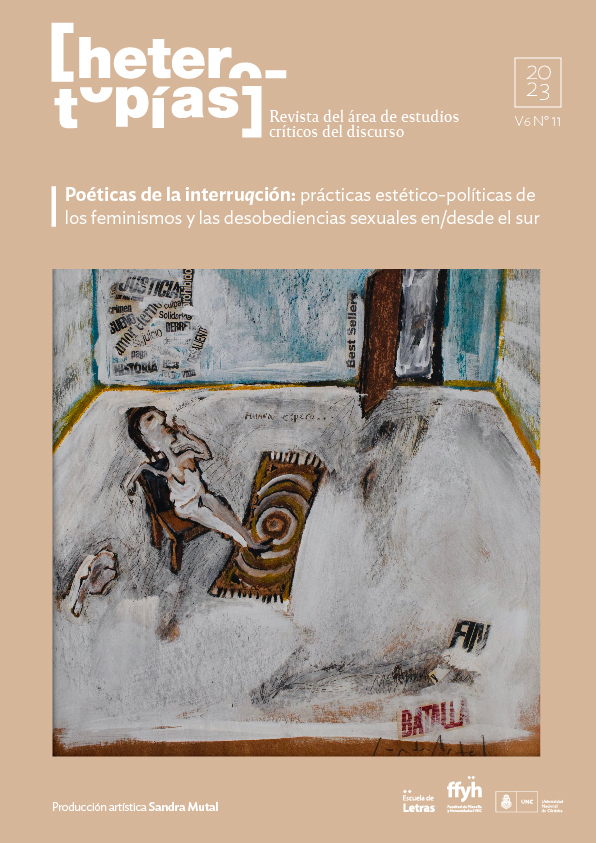Feminisms do not take quarantine. Feminist street interventions from Rosario in pandemic
Main Article Content
Abstract
The purpose of this article is to think about the aesthetic and political feminist practices in the public space of Rosario during the pandemic with a focus on the aesthetic dimension of social protest. The political street invention of feminisms in recent years produced an unprecedented magnitude and diversity of interventions and organizations. However, the advent of the pandemic brought alterations to this itinerary and implied rethinking the occupation of space and the disposition of bodies in a context of care measures. Taking into consideration the construction of a register in which a set of street interventions were systematized, qualitative methodological tools will be used to analyze the set of expressive tools used by the different collectives, the formats adopted by the street actions, and the spatiality of the interventions, that is, the forms of appropriation of public space.
Downloads
Article Details

This work is licensed under a Creative Commons Attribution-NonCommercial-ShareAlike 4.0 International License.
Those authors who have publications with this journal, accept the following terms: Those authors who have publications with this journal, accept the following terms:
a. The authors will keep their copyright and guarantee to the journal the right of first publication of their work, which will be simultaneously subject to the Creative Commons Attribution - Non-Commercial - Share Alike (by-nc-sa) Attribution License; no commercial use of the original work or any derivative works is allowed, the distribution of which must be done with a license equal to the one that regulates the original work.
b. Authors may adopt other non-exclusive license agreements for the distribution of the published version of the work (e.g., deposit it in an institutional telematic archive or publish it in a monographic volume) provided that the initial publication in this journal is indicated.
c. Authors are allowed and recommended to disseminate their work through the Internet (e.g. in institutional telematic archives or on their website) before and during the submission process, which may lead to interesting exchanges and increase the number of citations of the published work. (See The effect of open access).
How to Cite
References
Arbuet, Osuna C. y Gutiérrez, L. (2022). Disputar las nociones de cuidado en pandemia: intervenciones estético-políticas en Argentina, Brasil y Chile. L’Ordinaire des Amériques, 228. Recuperado de: http://journals.openedition.org/orda/7368
Bertolaccini, L. (2020). Plazas verdes. Estética y política en los activismos callejeros en torno a las demandas por aborto legal (Rosario, 2018). Artefacto visual, vol. 5, núm. 10, 65-91. Recuperado de: https://www.revlat.com/numero10
______ (2021). Desde el corazón de la marea. Estética y política en protestas sociales del movimiento feminista en Rosario. Rosario: UNR Editora.
Cabral, X. y Scribano, A. (2009). Política de las expresiones heterodoxas: el conflicto social en los escenarios de las crisis argentinas. Convergencia, 16, 51, 129-155.
Chávez Mac Gregor, H. (2009). Políticas de la aparición: estética y política. En Méndez Blake, J. (Comp.). La biblioteca muro. Vista del muro I (pp. 15-33).
______ (2015). Pese a todo, aparecer. Revista Re-visiones, 5, Instituto de Investigaciones Estéticas, Universidad Nacional Autónoma de México, México. Recuperado de: https://dialnet.unirioja.es/servlet/articulo?codigo=6829453
______ (2018). Ocupar el espacio. La batalla por la política. Recuperado de https://www.academia.edu/6335970/Ocupar_el_espacio.
Cuello, N. (2015). Flujos, roces y derrames del activismo artístico en Argentina (2003–2013): Políticas sexuales y comunidades de resistencia sexoafectiva. Errata,12, 70-95. Recuperado de: https://www.aacademica.org/nicolascuello/22
Di Filippo, M. (2015). Los movimientos sociales y sus prácticas estético- artísticas en el nuevo milenio. Un análisis del repertorio de protesta debido al asesinato de Pocho Lepratti en el 2001 argentino. En Valls, P. (Comp.) Fe de erratas: arte y política (pp. 48-63). Rosario: Ediciones Colaterales.
______ (2019). Estéticas políticas. Rosario: UNR Editora.
Expósito, M., Vindel, J., & Vidal, A. (2012). Activismo artístico. En Red Conceptualismos del Sur. Perder la forma humana. Una imagen sísmica de los años ochenta en América Latina (pp. 43-50). Madrid: Museo Nacional Centro de Arte Reina Sofía.
Giunta, A. (2009). Poscrisis. Arte argentino después de 2001. Buenos Aires: Siglo XXI.
______ (2019). Feminismo y arte latinoamericano: Historias de artistas que emanciparon el cuerpo. Buenos Aires: Siglo XXI.
Gutiérrez, L. (2018). Tortillear el paro. Imágenes y visibilidades lésbicas en el Primer Paro Internacional de Mujeres. En Actas del IX Jornadas Debates Actuales de la Teoría Política Contemporánea. Universidad Nacional de Rosario. Recuperado de: https://www.academia.edu/38458102/Tortillear_el_paro_Im%C3%A1genes_y_visibilidades_l%C3%A9sbicas_en_el_Primer_Paro_Internacional_pdf
______ (2021). Imágenes de lo posible Una genealogía discontinua de intervenciones lésbicas y feministas en Argentina (1986-2013). Córdoba: Asentamiento Fernseh.
Haber, M. (2020). Aproximación y diferimiento: resonancias afectivas en el cuerpo político feminista. Revista Diferencia(s), 10, 101-114. Recuperado de: http://www.revista.diferencias.com.ar/index.php/diferencias/article/view/212
Laudano, C, (2016). Feministas en ‘la red’. Reflexiones en torno a las potencialidades y restricciones de la participación en el ciberespacio. En Rovetto, F. y Fabbri, L.(Comps.) Sin feminismos no hay democracia: género y ciencias sociales. Rosario: Último recurso.
_______ (2019). Acerca del uso estratégico de TIC en movilizaciones feminista. En Rivoir, A. y Morales, M. (Coords.). Tecnologías digitales: Miradas críticas de la apropiación en América Latina (pp. 357-369). Buenos Aires: CLACSO.
Longoni, A. (2009). Activismo artístico en la última década en Argentina: algunas acciones en torno a la segunda desaparición de Jorge Julio López. Errata, 16-35. Recuperado de: https://revistaerrata.gov.co/edicion/errata0-el-lugar-del-arte-en-lo-politico
Longoni, A., y Bruzzone, G. A. (2008). El siluetazo. Buenos Aires: Adriana Hidalgo Editora.
López, M. D. (2017). Cambio de piel. Intervenciones culturales, acción colectiva y politicidad emergente en el espacio público de La Plata. Tesis de Doctorado. UNLP.
Pérez Balbi, M. (2020). Habitar/Confabular/Crear. Activismos artístico en La Plata. La Plata: EDULP.
Proaño Gómez, L. y Verzero, L. (Comps.) (2020). Mutis por el foro. Artes escénicas y política en tiempos de pandemia. Red de Estudios de Artes Escénicas Latinoamericanas y Editorial ASPO. Recuperado de https://www.academia.edu/44767637/Mutis_por_el_Foro.
Vázquez, C. (2019). Las multitudes feministas en el espacio público: estéticas, afectos y política. Ponencia presentada en el XXI° Congreso de la Red de Carreras de Comunicación Social y Periodismo, realizado en la Universidad Nacional de Salta.
